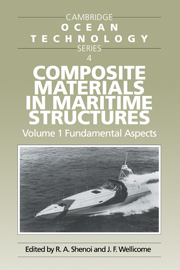Book contents
- Frontmatter
- Contents
- Preface
- List of Authors
- 1 A Strategic Overview
- 2 Background to Materials Science
- 3 Environmental Aspects
- 4 Production by Resin Transfer Moulding
- 5 An Engineering Approach to the Prediction of Elastic Properties of a Laminate
- 6 Mechanics of Orthotropic Laminae
- 7 Analysis of Laminated Composites
- 8 Theory of Sandwich Beams and Plates
- 9 Design of Anisotropic Panels
- 10 Finite Element Analysis of Composites
- 11 Theoretical Predictions of Failure Mechanisms and Strength
- 12 Considerations of Failure Theories in Design
- 13 The Procedures and Standards
- Appendix
- Index
11 - Theoretical Predictions of Failure Mechanisms and Strength
Published online by Cambridge University Press: 04 August 2010
- Frontmatter
- Contents
- Preface
- List of Authors
- 1 A Strategic Overview
- 2 Background to Materials Science
- 3 Environmental Aspects
- 4 Production by Resin Transfer Moulding
- 5 An Engineering Approach to the Prediction of Elastic Properties of a Laminate
- 6 Mechanics of Orthotropic Laminae
- 7 Analysis of Laminated Composites
- 8 Theory of Sandwich Beams and Plates
- 9 Design of Anisotropic Panels
- 10 Finite Element Analysis of Composites
- 11 Theoretical Predictions of Failure Mechanisms and Strength
- 12 Considerations of Failure Theories in Design
- 13 The Procedures and Standards
- Appendix
- Index
Summary
INTRODUCTION
In this Chapter, failure mechanisms in polymeric composite materials will be reviewed with an emphasis on how to predict materials failure and strength. The Chapter covers the simple case of unidirectional (UD) composites through to laminates, notches, compression behaviour, damage effects, environmental behaviour and fatigue. Inevitably the number of theories relating to this topic are numerous and in this Chapter only the major ones have been reviewed with apologies for those omitted due to lack of space and time. Within these constraints this review will inevitably be fairly shallow, but reference to more detailed treatise will be made for the reader to follow up if desired. The bulk of the Chapter will comprise an overview of the academic approaches to composites predictive modelling.
Before presentation of specific predictive models, it is worthwhile first considering the classes of models available. Predictive models for composite strength generally fall into three categories, based either on general failure criteria, or what is loosely called damage mechanics or fracture mechanics. The first category, general failure criteria, includes maximum strain, Tsai-Wu etc. as well as those based on statistical fitting of data, popular in modelling fatigue behaviour. The second category, damage mechanics, covers all those based on the identification of failure modes and subsequent attempts to model behaviour, such as those by Beaumont at Cambridge University and the team at Surrey University. This approach often suffers from the disadvantage that information must be acquired on how the materials fail prior to the analysis and frequently does not include the capability to predict how failure occurs. The last category is energy based, often assuming fracture mechanics.
- Type
- Chapter
- Information
- Composite Materials in Maritime Structures , pp. 280 - 307Publisher: Cambridge University PressPrint publication year: 1993

